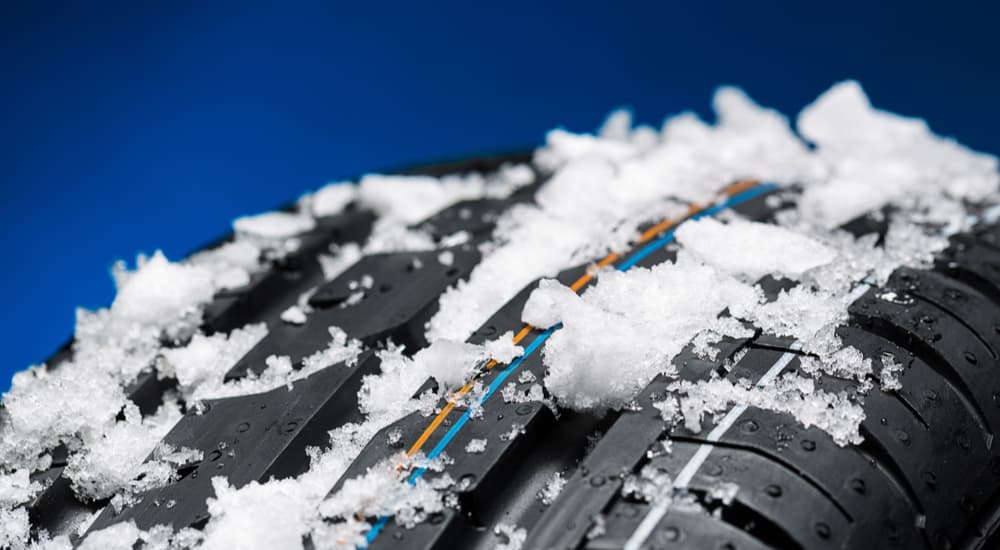Winter is guaranteed to arrive once a year and wreak havoc upon our streets. Once the snow and ice melts, life can return to a resemblance of normalcy, but until that happens, precautions have to be taken to make sure you get through it in one piece. In many ways, the process of preparing for the winter has become a ritual, especially if you live in New England or the Midwest. There’s the stockpiling of rock salt, checking to see if your snowblower is still operational, and of course, breaking into the attic and bringing down all that winter clothing that you were too eager to pack away in the first place. Speaking of wardrobe, you probably pull on your trusted winter boots before going anywhere—because the prospect of falling flat on your face in the snow isn’t just embarrassing, it’s also dangerous. Driving your car is very similar. Snow tires can be very beneficial when dealing with temperamental weather. But before you go out to a winter tire dealer, you need the right facts. We’ve compiled a quick and easy guide that assesses the pros and cons of putting winter tires on your vehicle.
What Exactly are Winter Tires?
As the title suggests, winter tires are specifically designed to operate in heavy snow, ice, and otherwise formidable winter conditions. Winter tires commonly have wide gaps in their tread patterns which prevents the build-up of snow and ice and allows for better traction while driving. Some winter tires even have metal studs that allow them to bite into ice for superior grip. Because of their design, winter tires are best used in temperatures less than 45 degrees. However, they are good in far more than just heavy snow and ice.
What’s the Difference Between Winter Tires and All-Season Tires?
All-season tires are best known for their versatility. They can be used all year long during any season and combine the performance of summer tires with enhanced bad-weather traction. Both winter tires and all-season tires have very similar tread patterns, so it’s assumed that all-season tires can live up to their name and function effectively in the snow. This is not the case. Winter tires have a wider pattern that allows for better traction in icy and snow-covered conditions. Another significant difference between the two is the rubber compound that winter tires are made from. Winter tires are made from a softer rubber, which allows them to maintain their consistency and not become brittle when temperatures drop below 45 degrees.

What Are Some of the Advantages That Winter Tires Have?
Are You Experienced?
Driving properly in the snow might be easy for an experienced driver who’s been doing it for years. However, someone who has not spent as much time navigating winter weather might face some formidable difficulties. For instance, icy roads can cause someone to lose control of their car and skid out of control. Someone who can’t react in time runs the risk of causing an accident and harm to themselves or others. Winter tires can give novice drivers some extra traction and help them get to where they’re going much safer.
Give Me A Brake
Icy roads and large snow banks aren’t the only things to be mindful of when you’re driving during winter. Your cars’ braking will be compromised when the roads are slick with ice and snow. During the winter, you have to come to a stop gradually, as a sudden stop can cause your car to lose traction and skid. The added grip from winter tires can help prevent your car from skidding when you come to a sudden stop on the road.
Less Wear and Tear
The more you drive your car, the more wear and tear you generate. Just like that periodic oil change you get every few months, your tires occasionally need to be balanced and rotated and replaced every now and again. Think of your winter tires the same way you do with your winter coat. You’ll only need it once during the year. Swapping the regular tires that you use the rest of the year with your winter tires means less wear on what you use during the warmer months of the year.
Avoid the Worry of Hydroplaning
During the tail end of winter, the snow begins to melt. This means a few things. First, those snowmen sitting on your front yard will soon be reduced to paste, and the tightly packed snow that’s on the roads will turn to the same consistency as a slushy. While this signals that a seasonal change is in the works, it also means that roads are getting wetter, and puddles will start forming. When your car passes over a large body of water, the risk of hydroplaning is there. This is where your tires completely lose traction with the road, and your car skids across the water. Because winter tires have deeper tread, the risks of hydroplaning during the early stages of a spring thaw are reduced.

Where Can I Get Winter Tires? When Should I Put Them On?
Like many other goods and services that are related to any season, winter tires might not be available all year long. While some tire shops carry all types of tires for the duration of the entire year, some might not have winter tires in stock until the season begins to change. It’s good to get them as soon as the temperature starts to drop; waiting too long might result in supplies running out. There is no perfect time to put winter tires on your vehicle. It’s best to use personal discretion, but experts agree that they’re best installed in mid-November and replaced with your normal tires sometime in March or April.
Are There Any Disadvantages That Come with Winter Tires?
Just like the battery in your car, there’s a negative side to correspond with the positive when it comes to winter tires. Thankfully, there’s not a lot of negativity. And once you own a pair, you’ll easily see that the advantages far outweigh the disadvantages.
There is a Season, Turn! Turn!
Just as their name might suggest, winter tires are ideal for winter and not recommended for the rest of the year. Leaving them on your car all year long can be bad for them and even the streets you drive on if you use studded tires. While winter tires will help you handle your vehicle in the snow, they have less grip and don’t handle as well as all-season tires when the weather is warm and dry.
Cost Effectiveness
The best things in life are free, but winter tires aren’t. While snow tires are competitively priced with any other brand or type of tire on the market, you can still expect to pay $600 or more for a decent set. When it comes to putting them on your car, it’s best if you have this procedure done by a professional. A faulty tire can be very dangerous, especially during extreme weather conditions.
Taking Up Space
Just like any other big purchase you make, you’ll need to find space to store your winter tires. They tend to take up a considerable amount of room, and moving them around might be difficult. They should also be stored in a cool environment protected from weather, which can be difficult if you don’t have a garage.

